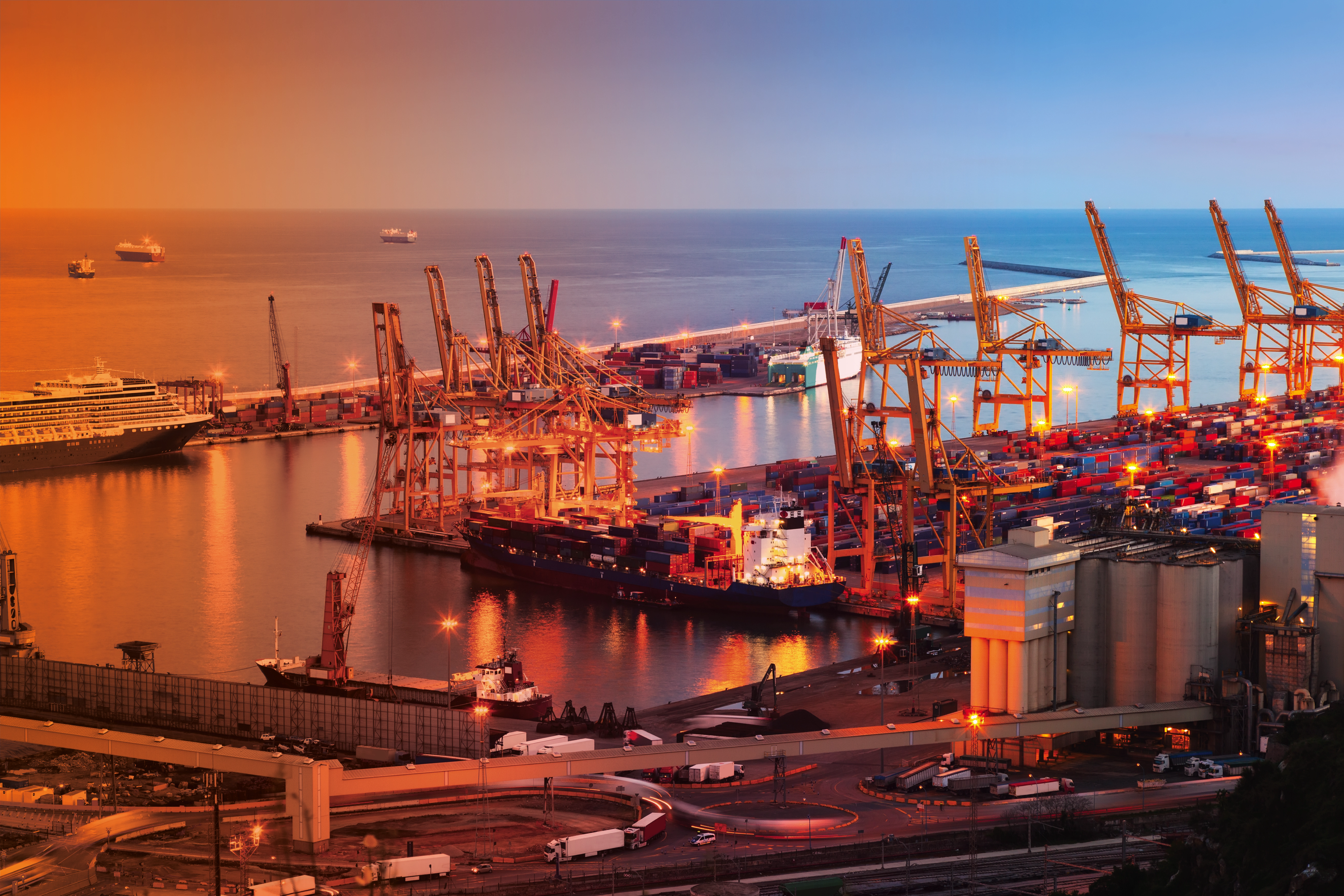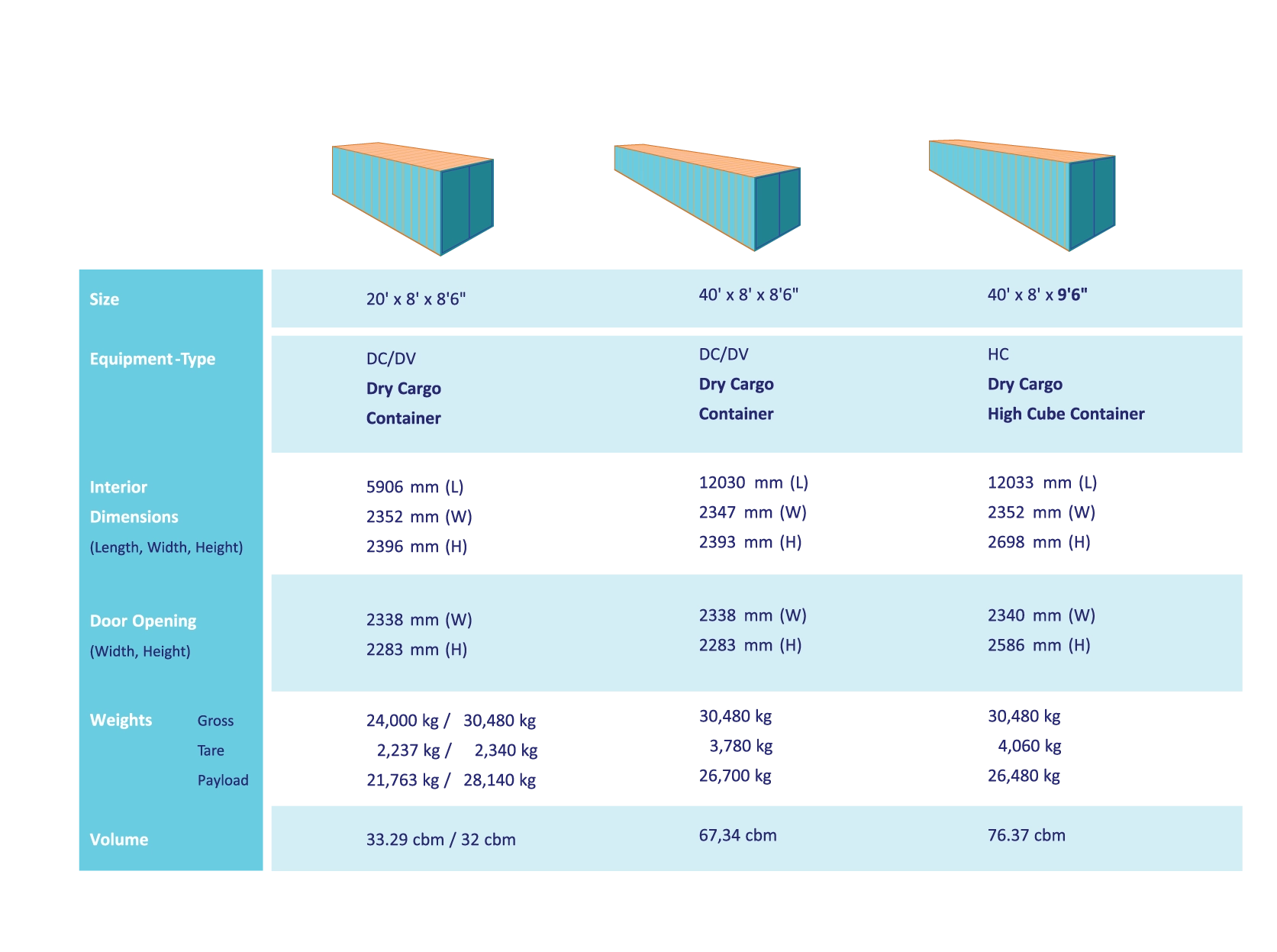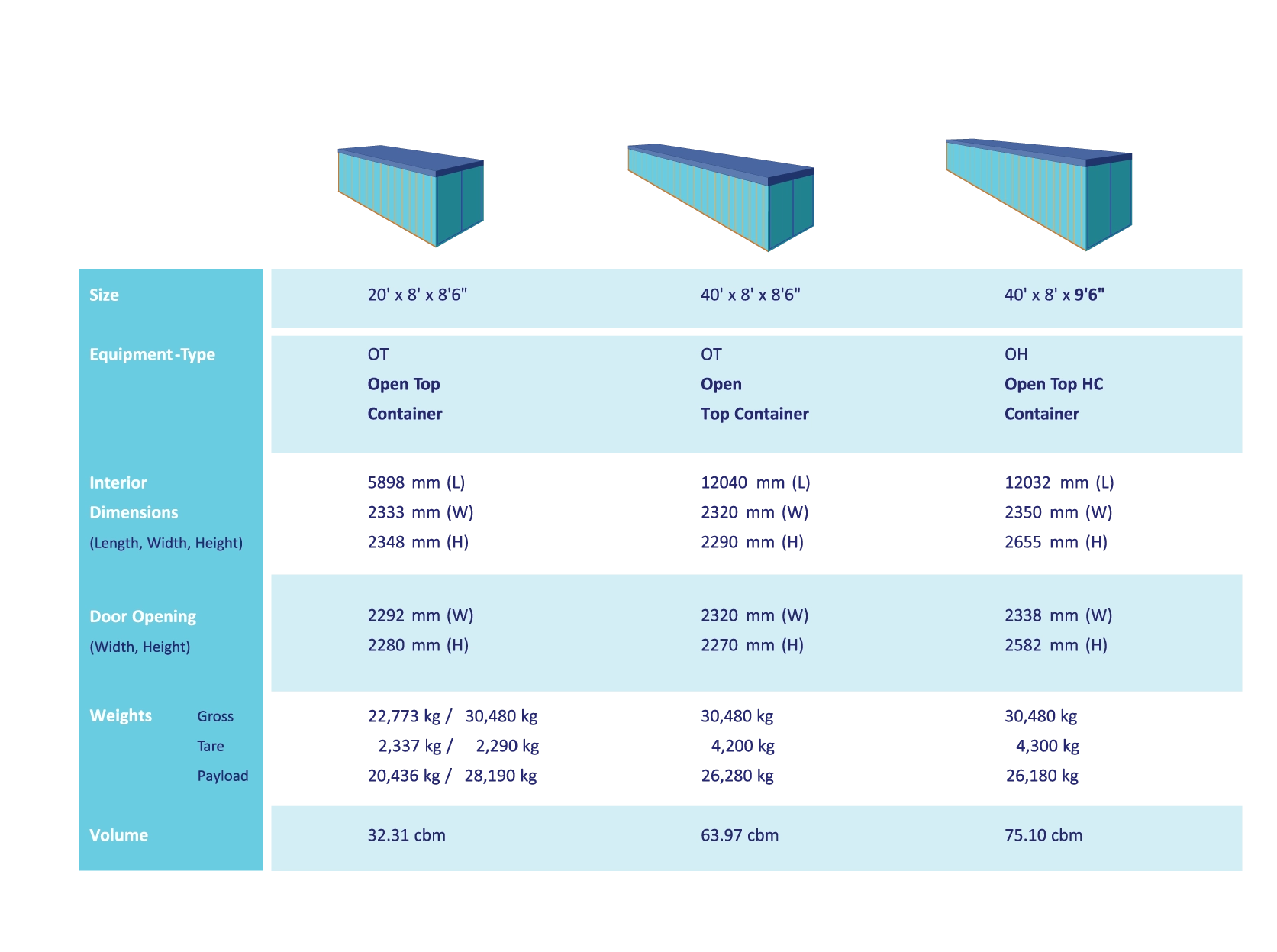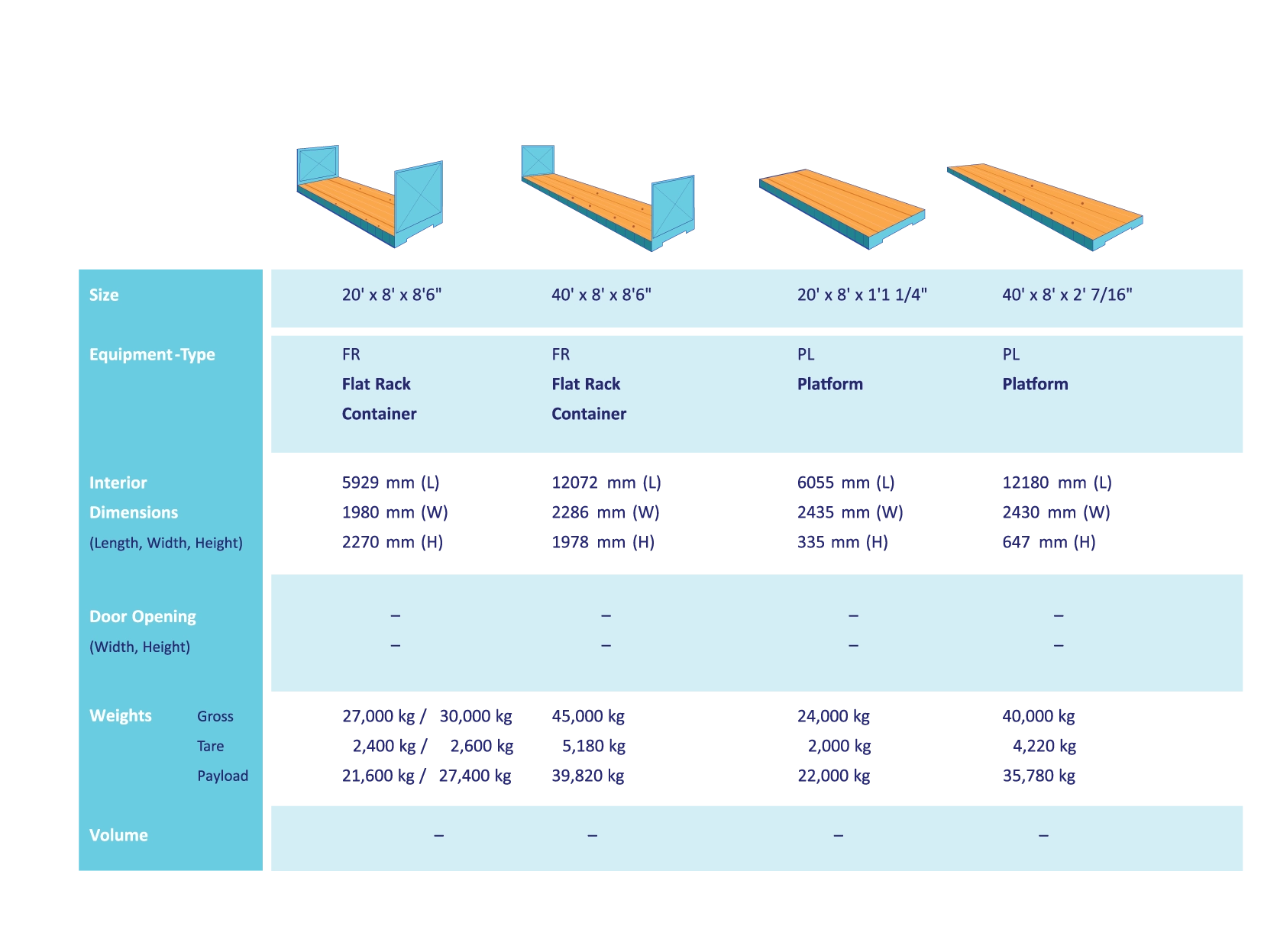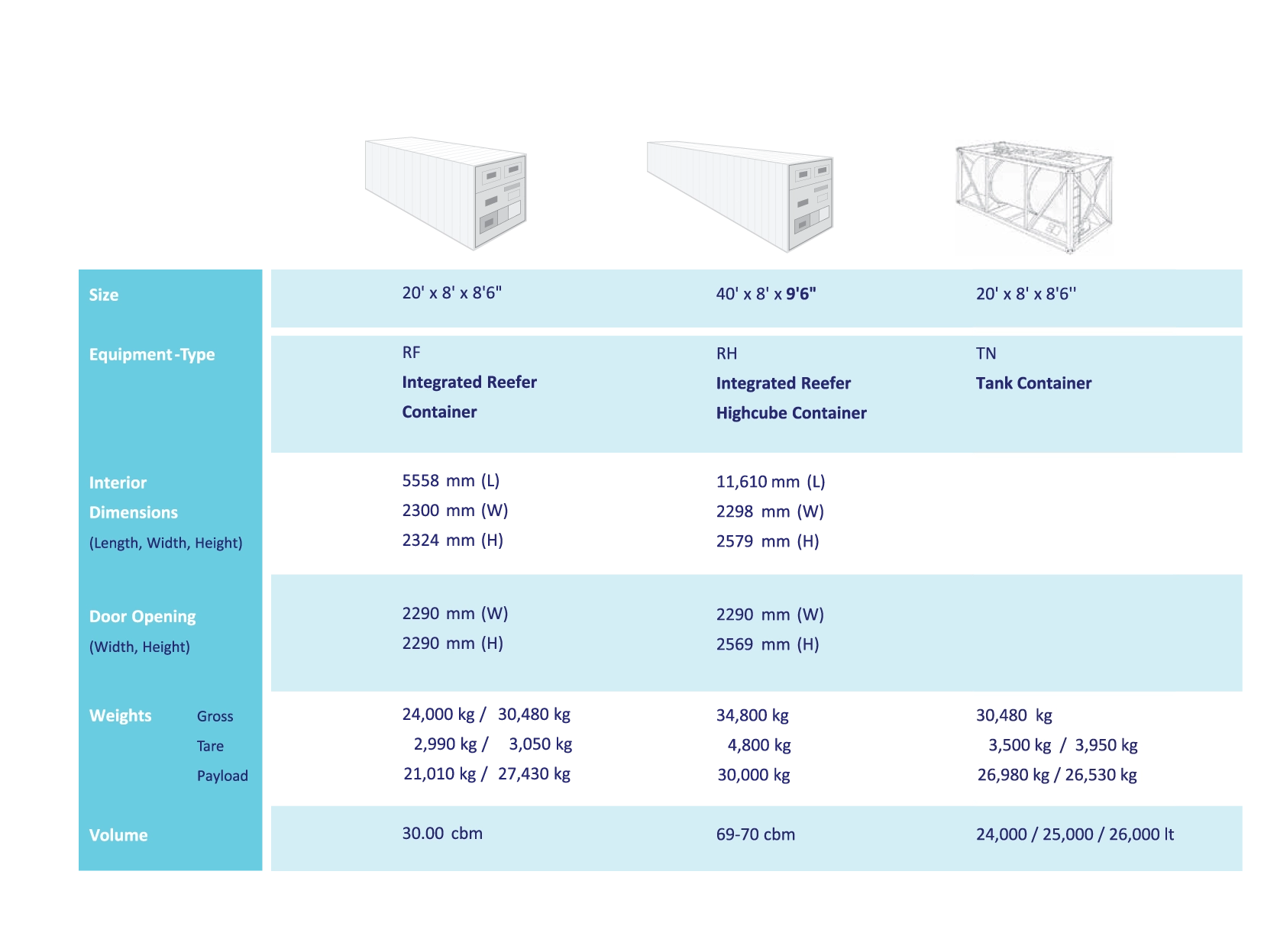Transportation Information
Standard Containers (Dry Van)
Standard containers are general-purpose containers used for transporting various dry goods. They are typically available in lengths of 20′ and 40′, but options in 45′ and, more recently, 54′ lengths are also available.
High Cube Containers
High Cube containers have a similar structure to standard containers but are 2896mm high instead of 2591mm, providing a larger interior volume. They are generally produced in 40′ lengths and are preferred for transporting all types of dry cargo, lightweight and bulky goods, and cargo up to 2.7m in height.
Note:All container sizes indicated are approximate. Shippers should consider tolerance margins.
Open Top Containers
Open Top containers are characterized by having a completely open top. After loading, they are covered with a tarpaulin. They are generally available in 20′ and 40′ lengths and are ideal for large loads that cannot fit through the container door and for cargo handled with cranes and other equipment.
Note:All container sizes indicated are approximate. Shippers should consider tolerance margins.
Flat rack Containers
Flat rack containers consist of a base platform and two end walls. The end walls can be vertically secured or folded down onto the base, converting it into a transport platform. They are usually produced in 20′ and 40′ lengths and are used for transporting heavy, wide, or tall loads. Multiple flat rack containers can be combined for transporting and securing high-volume break bulk cargo.
Platforms (Plats)
Platforms are structural transport vehicles with only a base platform. They have no side or end walls and are suitable for transporting heavy loads in a small area. Generally produced in 20′ and 40′ lengths, they are preferred for transporting oversized and heavy loads.
Note:All container sizes indicated are approximate. Shippers should consider tolerance margins.
Refrigerated (Reefer) Containers
Refrigerated (Reefer) containers are specially insulated containers with a cooling unit inside. They are generally produced in 20′ and 40′ lengths. High Cube versions are used for transporting lightweight and bulky goods (e.g., flowers, fruits). They are ideal for transporting food products that require a constant temperature, designed for products kept below or above 0ºC.
Tank Containers :
Tank containers are used for transporting liquid or gaseous cargo. These containers contain a cylindrical tank placed inside a steel rectangular structure.
Note: All container sizes indicated are approximate. Shippers should consider tolerance margins.
Delivery Terms: Responsibilities and Terminology
In international trade, delivery terms are determined by standard terms used in each country, clearly defining the responsibilities of the seller and the buyer. Delivery terms indicate who is responsible for transportation, loading, unloading, customs procedures, insurance, and damage. These terms must be explicitly stated in international trade contracts. The more responsibility the seller assumes, the more it usually reflects on the price. Delivery terms are generally expressed using English abbreviations. Here are the internationally standardized delivery terms and the responsibilities they impose on the parties:
EXW (Ex Works)
The seller delivers the goods to the buyer at the seller’s premises. Delivery takes place at the seller's workplace in their country, and customs procedures are not performed by the seller. The seller’s responsibility is limited to making the goods available at the specified place and time. This delivery term imposes the least responsibility on the seller and the most on the buyer.
FCA (Free Carrier)
The seller delivers the goods, cleared for export, to the carrier at the place specified by the buyer. The place of delivery is in the exporter’s country, and transportation costs are borne by the buyer. Loading is the seller’s responsibility unless otherwise agreed.
FAS (Free Alongside Ship)
The seller makes the goods available alongside the ship at the specified port, with export customs clearance completed. Loading the goods onto the ship, import clearance, and transport costs are the buyer’s responsibility.
FOB (Free on Board)
The seller's responsibility ends when the goods pass the ship's rail. From that point onward, the buyer assumes responsibility. Loading is the seller's responsibility.
CIF (Cost, Insurance and Freight)
The seller pays for the freight and maritime insurance. Ownership of the goods passes to the buyer once they cross the ship's rail. Insurance procedures are handled by the buyer.
CFR (Cost and Freight)
The seller pays for the freight and delivers the goods to the destination port. The risk of loss and damage to the goods passes to the buyer once they cross the ship's rail.
CPT (Carriage Paid To)
The seller delivers the goods to the carrier and pays for transportation to the specified destination. The buyer is responsible for import clearance and insurance.
CIP (Carriage and Insurance Paid To)
This is the version of CIF used for non-maritime and multimodal transportation. The seller provides and pays for transport insurance.
DAF (Delivered at Frontier)
The seller delivers the goods to the specified frontier, not unloaded from the transport vehicle. Import procedures and further transport responsibilities rest with the buyer.
DES (Delivered Ex Ship)
The goods are delivered on board the ship at the specified port of arrival. All costs and responsibilities until the arrival at the destination port are borne by the seller.
DEQ (Delivered Ex Quay)
The goods are unloaded from the ship and delivered on the quay at the specified destination port. This term is used only for maritime transport.
DDU (Delivered Duty Unpaid)
The seller delivers the goods without customs duties paid at the specified destination. All responsibilities transfer to the buyer after delivery.
DDP (Delivered Duty Paid)
The seller completes import customs clearance and pays all costs to deliver the goods to the buyer. This delivery term imposes the least responsibility on the buyer.
The selection of delivery terms requires a cost-benefit analysis. As the seller’s responsibilities increase, so does the price; conversely, by taking on more responsibilities, the buyer can reduce costs. When choosing a delivery term, it's important to evaluate both the costs and the benefits of each option. Additionally, legal factors should be considered, such as whether the seller and buyer can handle customs clearance procedures.
Classes of Dangerous Goods
ADR is the abbreviation for “European Agreement concerning the International Carriage of Dangerous Goods by Road,” and stands for “Accord européen relatif au transport international des marchandises Dangereuses par Route.” This agreement regulates the international transport of dangerous goods by road. At Mer Shipping, we emphasize that the primary purpose of ADR is to make the transport of dangerous goods safer and prevent potential accidents.
Dangerous Goods Classes
Under ADR, dangerous goods are classified into 9 classes:
1. Explosive Substances
Includes substances that carry a risk of explosion, such as dynamite and gunpowder.
2. Gases
Covers compressed, liquefied, or dissolved gases, such as oxygen and nitrogen.
3. Flammable Liquids
Includes flammable liquids, such as gasoline and diesel fuel.
4. Flammable Solids, Self-Igniting, and Water-Reactive Substances
Covers solids that are flammable, self-igniting, or reactive with water.
5. Oxidizing Substances and Organic Peroxides
Includes oxidizing agents and organic peroxides.
6. Toxic and Infectious Substances
Covers toxic substances and those that can cause infections, which may be harmful to human health.
7. Radioactive Materials
Includes substances with radioactive properties.
8. Corrosive Substances
Covers substances that can corrode metals and other materials.
9. Miscellaneous Dangerous Goods
Includes other dangerous goods that do not fall under the above classes.
Transporting Dangerous Goods
Transporting dangerous goods requires special regulations and rules. Care must be taken to avoid harm to human health and the environment during the transportation process. Mer Shipping prioritizes transportation safety by fully complying with ADR and other international regulations for transporting dangerous goods.
Storage of Dangerous Goods
Storing dangerous goods safely requires maintaining appropriate storage conditions according to their respective classes. Mer Shipping ensures the safe storage of all flammable and chemical materials with ADR-compliant storage facilities.
In Conclusion:
ADR and dangerous goods classes are of great importance for the transportation and storage of dangerous goods. These classifications are used to increase safety in the transportation sector and prevent environmental damage. At Mer Shipping, we fully comply with ADR to ensure safety in international transportation.
